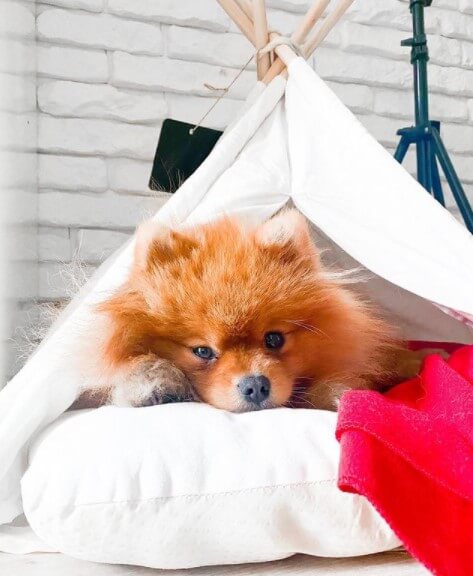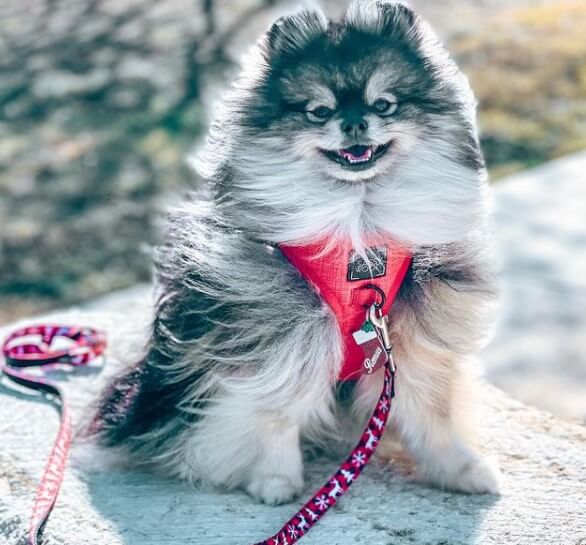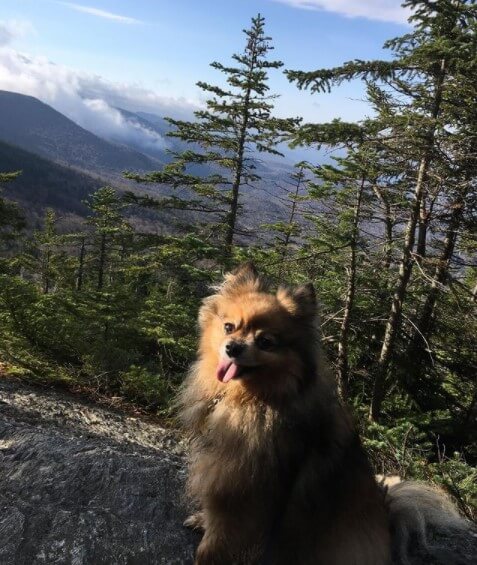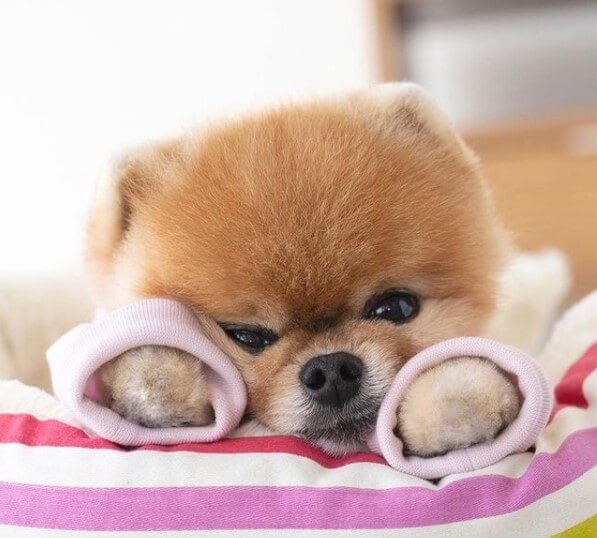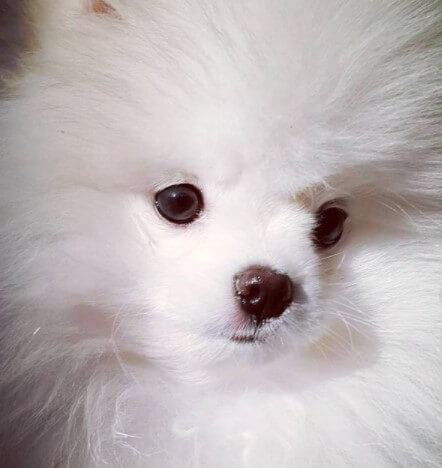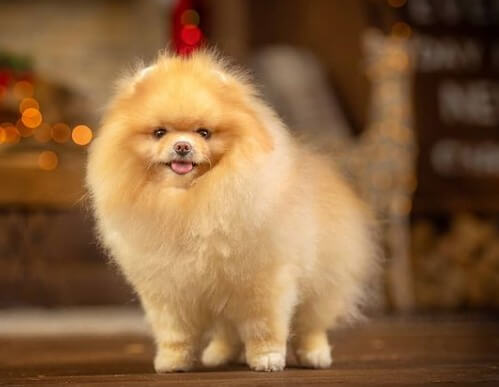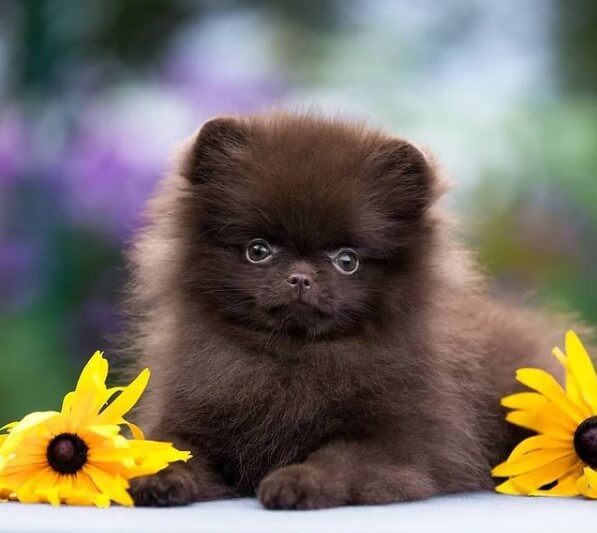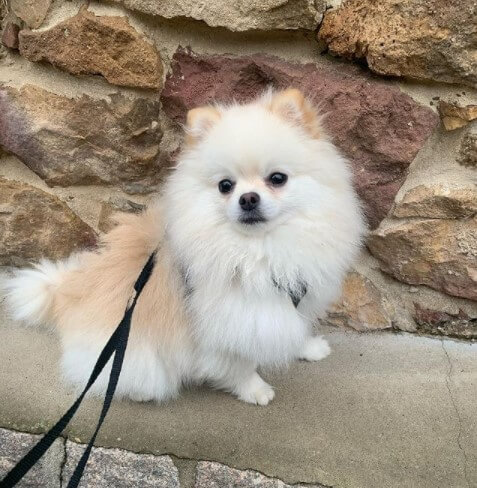The Pomeranian is a tiny fidget with a pretty face who cannot imagine life without active walks in the fresh air. The breed combines remarkable intelligence and temperamental character of large relatives. This teddy bear fearlessly rushes to your defense if it sees the enemy in a random passer-by. Despite loyalty and love, the Pomeranian will not sit at the owner’s feet for a long time. For him, lying in the foliage and throwing out energy in an active game is much more interesting.
Brief Information
- Breed name: Pomeranian
- Country of origin: Germany
- Time of origin of the breed: XVIII century
- Weight: 1.4-3.2kg
- Height (height at the withers): 18-22 cm
- Life span: 12-16 years
Key Facts
- Pomeranian easily finds a common language with the owner, to whom he feels boundless love and loyalty.
- It is a wonderful friend and companion for the conscious kids. It is better to refrain from buying an animal for young pranksters.
- Differs in excellent watch qualities and loud “bell” notifies of the arrival of an unexpected guest.
- Not suitable for enclosure or chains. An apartment or a country house is an ideal place.
- The Pomeranian needs careful and regular grooming, active rest, and long walks. Before you start a representative of this breed, you should soberly assess your strength.
- Dogs love to bark, which is what bother their neighbors, and often their own owners.
- With the weak character of the owner, Pomeranian tends to show dominance and stubbornness, which are not easy to cope with.
- The breed is not suitable for novice dog breeders.
History of the Pomeranian Breed
Looking at the little ball coiled comfortably in an armchair, it is difficult to imagine that his ancestors were several times larger and lived in the territory of modern northern European countries. This is evidenced by archaeological burials of the Neolithic era. The so-called peat dogs were used for locomotion due to their endurance and strength. It is worth noting that this method is still widespread in Iceland and Lapland. In the southern territories, these dogs were bred to guard ships in ports or property. The era of the Middle Ages radically changed the attitude towards them: a pretty appearance and indomitable energy earned the love of the European aristocracy. Increasingly, noble ladies and august persons appeared at social events in the company of a four-legged companion.
The inhabitants of Germany were the first to show a sincere interest in the breed from which the Pomeranians originated. It was here that Hund Spitz dogs began to be bred, which by the 18th century spread throughout the medieval state. For a long time, dog handlers could not come to an agreement: where did the Pomeranian come from? The laurels passed either to the German city of Württemberg, the center of dog breeding or to Pomerania, the Prussian province. Many experts have made bold claims when comparing Spitz to dogs that lived in China, Ancient Egypt, and Greece. As a result, the right to be considered the homeland of this breed was assigned to Pomerania.
The first individuals weighed about 15 kilograms and were larger than today’s Pomeranians. Wanting to make the breed more compact, German dog breeders selected the smallest specimens for breeding. This business was continued in England, where the Pomeranian “played” with new colors.
Queen Victoria played an important role in the recognition of the breed. Like many before that, she could not resist the charm of Marco – Pomeranian, who met the queen in Florence and soon went with her to England. Over time, this made the breed popular.
The efforts of the English dog breeders allowed to change the size of the Pomeranians, which became much smaller in comparison with their German relatives. All animals were divided into two groups: individuals weighing less than or more than seven pounds (about 3.1 kilograms). As a result of many years of selection, English Pomeranians have become the standard that breeders from all over the world have tried to match. However, to this day, the smallest of the Pomeranians remain exactly the natives of Pomerania.
Back in 1892, this breed also conquered the inhabitants of America, where the dogs were brought from English kennels. Despite the fact that the Pomeranian Spitz was not recognized by the American Kennel Club (AKC), the animals immediately fell in love with their enthusiasm, playful behavior, and, of course, silky fur. Everything changed with the beginning of the 20th century when the foundation of the American Pomeranian Club put a fat point in the process of recognizing the breed.
Eleven years later, the first exhibition was held, at which numerous breeders of Pomeranians competed for the right to become the best. By that time, the Spitz could boast of a whole palette of colors. Animals in black, white, chocolate, cream, and blue shades caused everyone’s admiration!
Despite the visible progress in breeding Pomeranians, American dog breeders continued to work on improving the breed but soon gave up trying to make the animals more miniature. The severe decrease in body proportions led to the impossibility of procreation, which negatively affected the breeding of dogs. It was experimentally revealed that it is most difficult to maintain the blue color of Pomeranians, and the white Spitz looked larger than their relatives with different coat colors and therefore participated in exhibitions less often.
It should be noted that it was on the American continent that the correct name was fixed for the breed – Pomeranian. Others mistakenly called the Spitz German. Now, this trend is less common, although in the FCI classification Pomeranians are still registered under the name “German Spitz”.
This breed has come a long but interesting way from service northern dogs to favorites of noble persons. Now Pomeranians are regular participants in various exhibitions and events. Animals delight with their intelligence, perky character, and thick hair inherited from their ancestors. Their compact size, combined with a big heart, makes Pomeranians great companions and loyal friends.
Description of the Pomeranian Breed 
Of course, modern Pomeranians are somewhat different from dogs from the 19th century, but this refers more to size, but they have not lost their charm. Today these are small dogs with a fluffy ringtail and fox eyes, outwardly resembling a plush toy.
According to the standard, pets of this breed have a strong constitution:
- The head is medium in size, the transition from the forehead to the muzzle is clearly defined. The forehead is round and wide.
- The muzzle is shorter than the frontal region, but not pointed, with dry, tight-fitting lips, pigmented in black.
- The teeth are small, with a scissor bite. Ears are triangular, set close, erect.
- The eyes are medium, slightly slanted, they give the animal a slightly cunning look.
- The neck is not short, but because of the rich fur coat, it seems quite small. The ribcage differs in depth and width. The back creates a straight line and merges into a short lumbar girdle.
- The front and hind legs are straight and parallel to each other. Paws are compact and round.
- High tail, medium length.
Pomeranian Colors
Pomeranians have a distinctive feature – the coat that stands upright and makes the dog so attractively fluffy. If we talk about colors, then there are a dozen of them. However, the full color of the coat appears only by six months, when the puppy undergoes shedding for the first time.
The main open classes for the color of the coat include the following individuals:
- bright red

- white

- cream

- black

- brown

- blue

Personality
The owners of these adorable Pomeranians note their good-natured nature, unbridled curiosity, and cheerful enthusiasm with which fluffy balls explore the world even within the apartment. You should not start a Spitz as a decorative dog with which you can lie on the couch and watch your favorite movie. The Pomeranian prefers active games, and a walk in the fresh air is a delight. A dog of this breed will gladly bring a thrown ball, chase after a pigeon nesting on the curb, and rush to protect the owner from the “threat”. In general, a fun walk with a fluffy fidget is guaranteed.
Pomeranian easily finds a common language with the owner, adapting to his lifestyle. The faithful dog will never make noise in the early morning if you prefer to get up around noon and will follow on your heels as soon as you wake up. Representatives of this breed are attached to the family in which they live and can be sad if they are not given proper attention. Many Spitz owners note that returning home after work is fraught with a remarkable manifestation of love from the little bear cub. Your dog will always be there for you: during the preparation of dinner, showers and sleep at night. Some animals can sleep in a room with their owner (sometimes next to them on the bed) to please in the morning with another portion of affection and a loud call to take a walk in the city park.
The Pomeranian has a tendency to bark and responds with a flooded “voice” to any suspicious rustle. This dog makes an excellent watchman who will scare away an intruder, forgetting about its miniature size. Sometimes the Spitz can bark for no reason, and then the owner will have to gently adjust the habit of his pet.
If you are planning to take a dog as a friend for a child, the attitude towards the new family member should be conscious and careful. The Pomeranian will be happy to accompany the children in a fun game if he is used to their company as a puppy. Otherwise, the dog will prefer to remain an outside observer.
Pomeranian behaves with restraint with strangers and only in the absence of proper upbringing can bark at a casual passer-by. The dog reacts cautiously to general affection and not everyone will allow them to run their fingers into a soft plush fur.
Spitz gets along well with other animals, but sometimes it shows the habit of dominating its relatives. The appearance of a second dog in the house is a wake-up call for the Pomeranian: you need to show the owner and the new furry rascal who is in charge. However, if Spitz grew up with other animals, these problems will not arise. Carefully introduce your pet to decorative rats, hamsters, parrots, and others: the Pomeranian’s hunting instincts can manifest themselves at the most unexpected moment.
Training
The Pomeranian is naturally gifted with a highly developed intellect, which greatly facilitates the learning process (in comparison with other decorative dog breeds). However, a stubborn and independent nature can become a serious obstacle to the execution of commands. Forget about traditional training methods: they don’t work in this case. You will have to find a special approach to your pet.
The main thing in the upbringing of a Pomeranian is to forget about his touching appearance. Often, the owners of these dogs treat them as if they were children, considering their pets to be small and still unable to follow complex commands. The Pomeranian needs a confident owner who can show strength of character and has leadership qualities. Only in this case, the dog willingly gives in to training, learning both basic commands and tricks worthy of circus performances. If the spitz considers himself a step higher than you, he will defiantly refuse to listen to any exhortations and requests to sit down, lie down, or give a voice.
Delicate pet handling and tasty reward is the most effective approach to training this breed. The Pomeranian does not like criticism and responds to the manifestation of cruelty or disrespect with willfulness, insolence, or even aggression. A naughty dog will bring a lot of trouble to the owner, so first, you need to teach your pet to perform the simplest actions: sit, lie down, approach the leg, go to the place. The command to stop barking is no less useful: the high and sonorous intonations of the “voice” will not please everyone.
In general, dog breeders characterize the Pomeranian as a smart creature that is easy to train with the right approach to training. The only problem that can arise is toilet training. Due to the structural features of the Pomeranian, it is difficult to keep the contents of the bladder long enough, so the dog can relieve himself right in the apartment. However, if you have the patience to teach your pet to ask for a walk-on time, the cleanliness of your home will remain intact. Especially creative dog breeders teach the Spitz to go to the litter box.
Conditions of Detention and Care
Long and fluffy hair is the main asset of Pomeranians, so a large proportion of grooming falls on thorough combing. This breed sheds twice a year. At the same time, the first molt occurs in the fourth or sixth month, when the “adult” wool cover replaces the puppy’s fur. In Pomeranian girls, molt begins during estrus and after childbirth, so do not be afraid. However, constant bald patches should make you think about changing your pet’s diet and choosing new cosmetics for hair care.
It is not recommended to bathe Pomeranians more than once or twice a month (as needed). To do this, use diluted longhaired shampoo: a concentrated product can have the opposite effect. Be sure to condition the velvety coat of the dog and dry it thoroughly with a hairdryer. Use a long-toothed comb. Please note that when brushing, the coat must be damp, so you should always have water softened with the same conditioner at hand. The shedding period requires a more thorough combing.
The teeth of the Pomeranian are cleaned with a special paste 3-4 times a week. To do this, you can use a brush or attachment. A piece of bandage wrapped around your finger will do. In order to avoid the appearance of tartar and further treatment, it is recommended to include solid food in the pet’s diet.
The claws are cut with a special nail clipper. Don’t forget to cut the resulting sharp edges with a nail file. Paw pads deserve care too: rub in vegetable oil and painful cracks will never bother your pet!
Feeding
Pomeranian nutrition should be balanced. For this, dry food with a maximum content of essential minerals and vitamins is suitable. Natural food is just as healthy, but in any case, do not treat Spitz with food from the table. Food should always be fresh and at room temperature. Do not forget about the sufficient amount of water, which must be changed daily.
Health
The northern origin rewarded the Pomeranian with good health in comparison with other dwarf breeds. Even in old age, these lively bears feel great.
Some dogs suffer from alopecia – baldness of certain areas of the body. Especially frightening is the so-called black skin disease, which is fraught with complete hair loss and skin pigmentation. However, the disease itself does not harm the Spitz’s health, limiting itself only to the unattractive appearance of the animal.
Most susceptible to diseases are Pomeranian merle color. They are born deaf, with increased intraocular pressure and coloboma – a defect in the lining of the eyes. Violations in the functioning of the cardiovascular, musculoskeletal, and nervous systems are observed.
How to Choose a Puppy
Before you take a new pet into the house, you need to decide on its future fate. Show-class puppies are the best suited for participation in exhibitions. Breed-class dogs are bought mainly for breeding. If you see a wonderful friend and companion in the Pomeranian, pay attention to pet-class puppies – and you will not go wrong.
When choosing a Pomeranian puppy, you need to pay attention to his health and appearance. A healthy baby should be lively, playful, and playful, show curiosity towards you and not be afraid of an outstretched hand. The size of the puppy should not determine your choice: even the smallest specimen can grow into a large dog.
The gender of the baby in most cases determines his behavior in the future. Males are distinguished by cockiness and stubbornness, while females are tender and agreeable, although there are exceptions.
